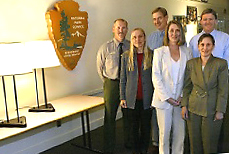|
On a recent foggy afternoon in San Francisco, National Park Service and
Department of Energy officials gathered at Fort Mason's General Headquarters
building to celebrate the latest step in the "greening" of the
national parks.
|
|
 |
 |
|
|
 |
(From left) Don Mannel, Mai-Liis Bartling,
and Steve Butterworth of NPS, Kathy Pierce of DOE, George Turnbull
of NPS, and Marcy Beck of Berkeley Lab. |
|
|
The Golden Gate National Recreation Area, one of 385 National Park Service
(NPS) sites, has installed 50 energy-efficient Berkeley Lamps in its offices
at Fort Mason, with the assistance of the Department of Energy and Berkeley
Lab's Environmental Energy Technologies Division. Developed by Berkeley
Lab lighting researchers, the Berkeley Lamp has been shown to reduce lighting
energy use in offices up to 50 percent.
The Golden Gate National Recreation Area is an urban national park encompassing
75,500 acres in the San Francisco Bay Area. The park contains such well
known sites as Alcatraz Island, Muir Woods and Presidio of San Francisco.
Steve Butterworth, the Park Service's regional energy manager, worked
with Berkeley Lab lighting researchers Michael Siminovitch and Erik Page
to ascertain that the Berkeley Lamp would bring substantial energy savings
to their facility. Their first collaboration was developing a handbook
of energy-efficient lighting retrofits for National Park Service facilities
managers.
"The project was originally funded as a standard lighting retrofit,"
said Butterworth. "But by installing the Berkeley Lamp, we were able
to avoid the expense and the waste stream of ripping out old fixtures,
ballasts and tiles, as well as the indoor air quality problem of the renovation.
The cost to purchase the Berkeley lamps was less than the labor would
have cost in the original plan, and the waste stream from the new product
packaging was also much less."
Park Service Commitment to Sustainability
"Our goal in the National Park Service," said George Turnbull,
regional coordinator of the Park Service's sustainability program, "is
not only to comply with but to exceed the requirements of environmental
regulations."
Turnbull added that installing Berkeley Lamps to lower energy costs was
only one of many steps NPS is taking to become a leader in environmental
sustainability. Other projects currently underway or completed include
installing solar photovoltaic systems in Joshua Tree National Park, the
Mojave National Preserve, and other parks; being the first to install
a fuel cell in a national park campground; replacing conventional with
biomass-based diesel power in the Channel Islands National Park; and choosing
concessions based on vendor commitment to sustainability.
"We take sustainability seriously," said Mai-Liis Bartling,
acting regional director for the Golden Gate National Recreation Area.
"We were the first National Park to request Berkeley Lamps, and now
we have 50 of them. The lamp allowed us to bring energy-efficient lighting
into a historical building. The feedback from the staff has been extremely
positive. We want to expand the use of the lamp to other buildings."
Butterworth added "The public has been very supportive of our efforts
at sustainability. Having these technologies in these public spaces helps
educate people in how they can use the technologies themselves."
The Department of Energy's regional director, Kathy Pierce, who, like
Butterworth, flew down from Seattle for the occasion, said, "It's
wonderful to see an energy-efficient technology developed at one of the
national laboratories put to use by federal agencies. It demonstrates
that you can get anything done when you have good partners -- people who
are motivated to make something happen. We are looking forward to continuing
our partnership with the National Park Service to support energy efficient
and sustainable technologies."
Now, visitors peering through the San Francisco fog at the windows of
the fort's headquarters building can see a new beacon, one that represents
energy efficiency and sustainability: the warm yellow glow of Berkeley
lamps.
Additional information
|

